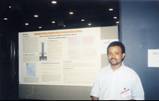Modeling Groundwater Denitrification by Ferrous Iron with PHREEQC

Tedros Tesfay has a B.S. in Chemistry from the University of Asmara, Eritrea, and a M.S. in Radiogenic Isotope Geochemistry from University of New Mexico, Albuquerque, New Mexico. He is currently pursuing his Ph.D. in Geology at the University of North Dakota with a research specialization of hydrogeology.
tedros@und.nodak.edu
Fellow: Tedros Tesfay, Department of Geology and Geological Engineering, UND.
Advisor: Scott Korom, Professor of Geology, UND.
Matching Support: In-kind contribution from Dr. Korom’s salary, waiver of indirect costs, a graduate tuition waiver
Degree Progress: Ph. D. expected in 2005.
Modeling Groundwater Denitrification by Ferrous Iron Using PHREEQC
Nitrate is one of the most common groundwater contaminants (Gillham and Cherry, 1979, Fetter, 1994). Denitrification is the only effective process that converts considerable amount of nitrate irreversibly into harmless nitrogen gas in groundwater environments (Korom, 1992). It is a natural process that requires an anaerobic environment, denitrifying bacteria, and sufficient and reactive electron donating species (Starr and Gillham, 1993). Numerous researchers show that the availability of electron donors within aquifer sediments limits the denitrification potential of aquifers (Trudell et al., 1986; Robertson et al., 1996). Korom (1992) explains that the three common electron donors for denitrification are organic carbon, sulfide (usually as pyrite), and ferrous iron. Efforts by members of the UND denitrification research team show organic carbon and sulfide are active electron donors for denitrification in seven of the North Dakota and Minnesota aquifers. We also believe ferrous iron is an active electron donor; however, the geochemical evidence for ferrous iron is more difficult to decipher and requires comprehensive knowledge of the hydrogeochemistry of the aquifers.
Denitrification is commonly estimated by measuring the reaction products. The geochemical evidence in five of the research sites shows that organic carbon and inorganic sulfides play a major role in converting nitrates to nitrogen gas. However, both electron donors do not account for all the nitrate lost. Likewise, the reaction products of the remaining two aquifers (Robinson, ND and Akeley, MN) do not reflect the involvement of organic carbon and sulfides in the denitrification processes. Our hypothesis is that ferrous iron is the major electron donor causing reduction of nitrates in the latter two aquifers and may also be involved to some extent in the other five aquifers as well.
Mixing of nitrate polluted water and reduced waters at depth trigger important multiphase aquifer hydrogeochemical reactions. Some of the common aquifer geochemical reactions are ion exchange, dissolution and/or precipitation of dominant minerals, and redox reactions (Tesoriero et al., 2000). Knowledge of the above reactions, which is the main reason behind this proposal, enables us to decipher the denitrification capacity of aquifers. Therefore, our objective is to use PHREEQC in order to understand the comprehensive hydrogeochemical environment that governs denitrification and other associated aquifer reactions. To understand the controlling multiphase geochemical reactions both the forward and inverse modeling schemes will be used. The forward modeling is constrained by equilibrium thermodynamics and the unknown variables are determined by solving the mass action equations. Inverse modeling is founded on the net mass transfer among the multiphase, aqueous, gases, and minerals and compares the initial and the final solutions. Mass balance modeling and cation exchange reactions will be given special emphasis in the project. Since the results of inverse modeling are not unique, and it doesn't consider the thermodynamic regulations of the system, equilibrium and kinetic factors are used as an elimination tool. More focus will be given to the electron donating species as we pursue the mass balance, equilibrium and/or kinetic methods.
Preliminary interpretation of all the completed tracer tests has been done. Collection of aquifer sediment samples of all the sites and part of the physical and geochemical analyses are also done. The remaining physical and geochemical analyses of the samples can be completed in a period of one year. In addition, PHREEQC has been shown to be effective in interpreting the denitrification reactions in the ISMs during the tracer tests (Skubinna, in preparation). Finally, modeling output will be compared with the field and laboratory results in order to verify both the numerical procedures as well as the hydrogeochemical reaction schemes.
Analytical and PHREEQC modeling results together will be expected to provide an insight into the denitrification capacity of all the aquifers and particularly a logical geochemical explanation for the Robinson, North Dakota, and Akeley, Minnesota, aquifers.

Scott F. Korom
Geology & Geological Engineering
UND


